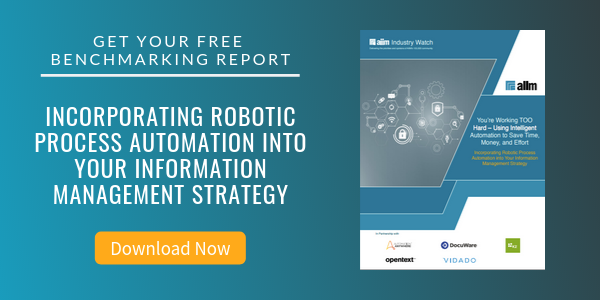
RPA – Is It the Answer to Our Dreams of Easier Business Automation?
Robotic Process Automation (RPA)
I’ve been involved in some way or another in the world of business process automation (BPM) for over twenty years. I was the author of AIIM’s first BPM training course back in 2006. I’m a big fan of the idea of reengineering business processes, but there is no getting away from the fact that BPM projects are complex and scary – they require buy-in from the top (which is always difficult) and are seldom inexpensive undertakings.
Add to that the fact that many projects fail, some spectacularly, due to the sheer complexity of the undertaking, and it should come as no surprise that organizations are looking for something simpler and more manageable; enter RPA (Robotic Process Automation).
RPA tools have come into the spotlight over the past year or so on a scale that few could imagine. RPA tools promise a low digital footprint and a low cost. They promise to be fast to implement and provide a simple approach to automating business processes. That’s a lot of big promises... and with so many big promises, we should approach the situation with a hefty amount of skepticism.
Though there is no doubt that RPA tools are here to stay, there can be a world of difference between the RPA tools available, and success is far from guaranteed. Selecting the right opportunities for RPA and understanding the key differences between RPA and BPM are critical. At the end of the day, RPA tools are designed to improve the quality of repetitive work tasks and reduce or remove the human labor involved. They can have a big impact on both business efficiency and the corporate structure and culture, but like any other technology used in the world of Information Management, all the options available are not equal.
At one end of the spectrum, we have tools that are very simple and built on long-established techniques. At the other end of the spectrum, we have tools that leverage modern machine learning and artificial intelligence capabilities. These are all labeled RPA.
Many of the use cases for RPA are mundane, such as reducing the number of manual keystroke entries in a process, but that doesn’t mean their value should be underestimated. Simple solutions to fix seeming intractable, but simple critical problems may well be the best way forward. That’s exactly what RPA promises.
Either way, the best way to determine if RPA is right for you is to learn about the fundamentals.
About Alan Pelz-Sharpe
Extensive experience in information & process management working with businesses and IT executives to analyse and define needs and priorities. Also advising technology vendors large and small to understand specific buyer patterns and goto market requirements. Over the years my clients have included FedEx, The Mayo Clinic, AstraZeneca, Shell & BP and public organisations including the Federal Reserve Board, Global Intelligence Agencies, State and National Governments.



